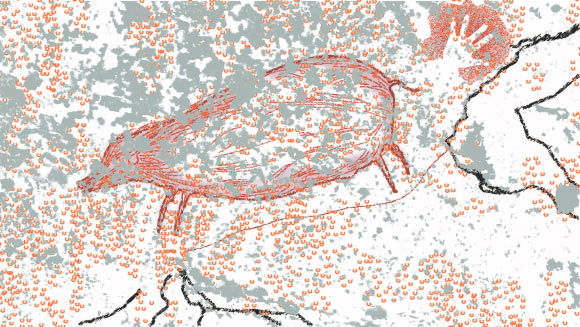
First recorded in the 1950s, paintings in limestone caves near Maros in southern Sulawesi, a large island east of Borneo, have been extensively studied by Indonesian researchers, although few detailed reports have been published.
They include human hand stencils (created by wet pigment blown by the artist onto the hand to outline it) and large naturalistic paintings of endemic Sulawesian mammals, including the dwarfed bovid anoa (Anoa sp.), Celebes warty pig (Sus celebensis) and the ‘pig-deer’ babirusa (Babyrousa sp.).
After new radiocarbon dating tests, they are believed to be up to 40,000 years old, making them some of the earliest known cave art in the world.
It was previously thought that cave art first emerged in Europe, with a minimum age of 41,000 years for the world’s oldest dated cave painting – a red disk on the wall of El Castillo cave in Spain.

This illustration shows the locations of the dated coralloid speleothems (red semicircles) and associated paintings: a hand stencil and a large naturalistic depiction of a babirusa. Image credit: M. Aubert et al.
However, the new findings from Sulawesi challenge this view. They show that at the same time as ancient Europeans were expressing themselves on cave walls, people in what is now Indonesia were doing the same.
“Europeans can’t exclusively claim to be the first to develop an abstract mind anymore. They need to share this, at least, with the early inhabitants of Indonesia,” said Dr Dosseto, who is the senior author of the paper published in the journal Nature.
Dr Dosseto and his colleagues from Indonesia and Australia dated 12 hand stencils and two animal depictions at seven cave sites on Sulawesi.
They determined the age of the paintings by measuring the ratio of uranium and thorium isotopes in coralloid speleothems (also known as cave popcorn) – small irregular stalactites with globular coral-like shape, which had formed over the art. Samples were shown to range in age from 39,900 to 17,400 years ago.
“Rock art might have emerged independently at about the same time in early modern human populations in Europe and Southeast Asia, or it might have been widely practiced by the first modern humans to leave Africa tens of thousands of years earlier – if so, then animal art could have much deeper origins,” said co-author Thomas Sutikna, also from the University of Wollongong.